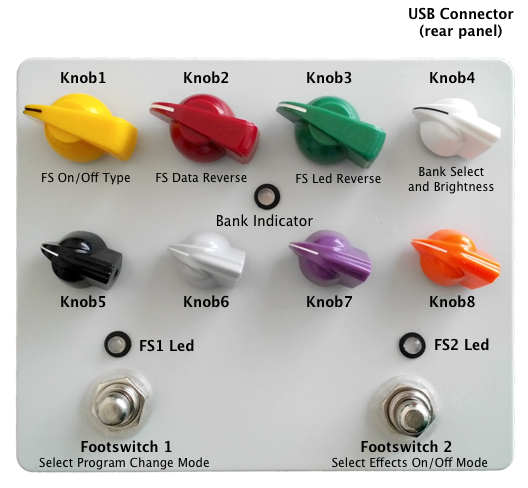There are a number of ways to take digital amp and effects modeling to the gig or studio, including the new AMPLIFi models from Line 6, or routing your signal through a laptop or tablet running something like AmpliTube. Accessing and controlling settings on a device screen can be somewhat fiddly, though, and many guitarists feel more comfortable with physical knobs and switches. This is where the Amperage MIDI controller pedal could help to bridge the gap between analog stomp familiarity and the brave new world of digital tone tweaking.
The Amperage Pedal is the brainchild of Kurt Olsen of North Shore Guitars, and has a familiar road-ready analog stomp form factor that's topped by eight chicken-head knobs, two footswitches and three LED status indicators, which can be adjusted for brightness. Each of the knobs can be used to send MIDI messages to a smart device or laptop running music creation or recording software, and custom-assigned to controls in the software running on the source machine.

There are a fair number of other MIDI interfaces already available of course, including IK Multimedia's iRig MIDI, but the Amperage Pedal's development team says that it's the number of knobs in one location, which can be matched to the primary controls of a computer-based modeling amplifier, that sets it apart from the rest. It's also a good fit for a pedal board. Though the labels on the photo above don't actually appear of the pedal itself, the top surface will be home to artwork by Andrew Towl.
By default, the knob to the top right is set to be used as a bank selector (though this can be chnaged if desired). There are seven banks, each of which produces a different color LED light at the center of the pedal. The footswitches can be used to send program change messages to the software, or set to act as latching or momentary switches for turning effects on or off. Pushing down and holding down both footswitches at the same time enters the unit into edit mode, where device behavior can be altered.
Usefully, holding down both footswitches simultaneously for 3 seconds allows the player to lock any of the available banks using the bank select knob, and effectively make all eight knobs available as MIDI controllers.
The Amperage Pedal is claimed compatible with any software or hardware capable of understanding MIDI, though a companion app has been created to allow users to change the pedal's default MIDI controller mapping and channels for each of the color-coded banks.
There are those who might argue that digital effects just don't offer the same warmth and response as analog stomps, and Olsen is not going to argue. He uses the old and the new for his own rig, with a laptop providing a huge library library of modeled tone, and tube amps and speaker cabinets for the output. The Amperage Pedal means that he can access and control his digital effects or modeling arsenal on stage without having to stop and click a mouse or touch an onscreen icon.

Olsen is readying a Makerbot Replicator 2 and a Shapeoko CNC milling machine for prototyping and low volume production runs. 3D models and schematics have been created to make upscaling to higher production runs relatively pain-free. Now all that's needed is funding. To that end, the Amperage Pedal project has launched on Kickstarter, where one unit is pitched at US$225.
If all goes according to plan, the first units will be built, tested and shipped in May and June. Backers will also receive Mac/Win audio hosting software called StageManager (to virtually wire up and chain digital amps and effects, all in one place).
"If the Kickstarter is unsuccessful, it will slow me down, but every instinct I have say's that modeling amps are going to become more common on stage," says Olsen. "The Amperage Pedal (and the follow-up product) can make a dent in the acceptance by the average guitarist. It did for me."
Have a look at the pitch video below to see what's on offer.
Sources: North Shore Guitars, Kickstarter











